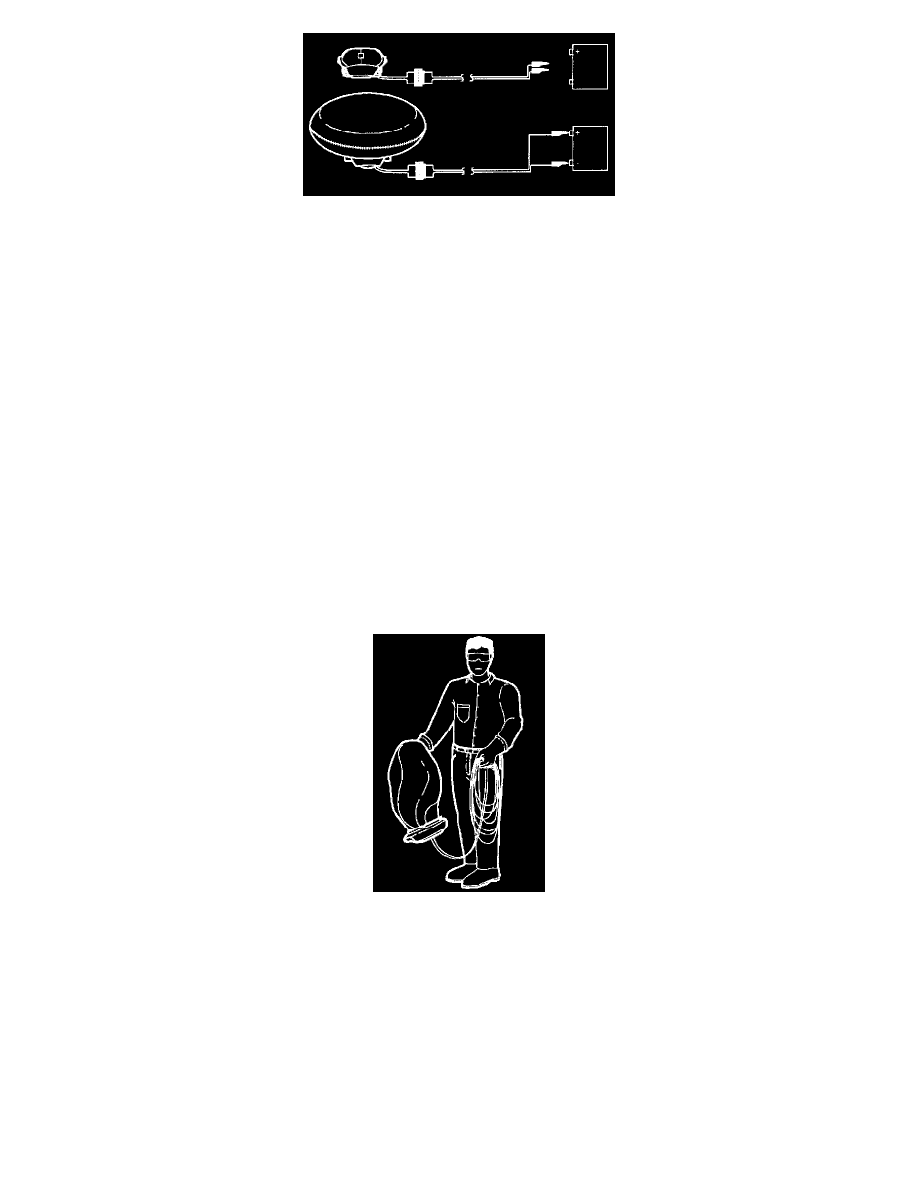SW2 L4-1.9L DOHC VIN 7 (1997)

17. In the unlikely event that the inflator module did not deploy after following these procedures, proceed immediately with steps 24 through 27. If the
inflator module did deploy, proceed with steps 20 through 23.
CAUTION: IMMEDIATELY FOLLOWING THE DEPLOYMENT OF AN AIR BAG, THE METAL SURFACES OF THE INFLATOR
MODULE ARE VERY HOT. DO NOT PLACE THE DEPLOYED INFLATOR MODULE NEAR ANY FLAMMABLE OBJECTS. WAIT
FOR ABOUT TEN MINUTES BEFORE TOUCHING ANY METAL SURFACE OF THE INFLATOR MODULE. DISREGARDING THESE
PRECAUTIONS MAY CAUSE FIRE OR PERSONAL INJURY.
After an inflator module has been deployed, the metal canister and surrounding areas of the inflator module will be very hot. Do not touch the metal
areas of the inflator module for about 10 minutes after deployment. If the deployed inflator module must be moved before it is cool, wear gloves and
handle by the air bag or vinyl trim.
After the inflator module has been deployed, the surface of the air bag may contain a powdery residue. This powder consists primarily of corn starch
(used to prevent bag from adhering to itself over the life of the product) and by-products of the chemical reaction. Sodium hydroxide dust (similar to lye
soap) is produced as a by-product of the deployment reaction. The sodium hydroxide then quickly reacts with the atmospheric moisture and is converted
to sodium carbonate and sodium bicarbonate (baking soda). Therefore, it is unlikely that sodium hydroxide will be present after deployment. As a
precaution, however, gloves and safety glasses are recommended to prevent any possible irritation of the skin or eyes.
18. Put on a pair of shop gloves to protect your hands from possible irritation and heat when handling the deployed inflator module. Safety glasses
should also be worn to protect your eyes.
19. Disconnect the pigtail adapter from the inflator module as soon after deployment as possible to avoid the possibility of damage to the pigtail
adapter or universal deployment harness due to possible contact with the hot inflator module canister. The universal deployment harness is
designed to be reused. It should, however, be inspected for damage after each deployment and replaced if necessary. The pigtail adapter, SA
9414Z, may become damaged because of high temperatures and should be discarded after deployment outside the vehicle.
20. Dispose of the deployed inflator module through normal refuse channels after it has cooled for at least 10 minutes.
21. Wash your hands with mild soap and water afterward.
IMPORTANT: The remaining steps are to be followed in the unlikely event that the inflator module did not deploy after following these procedures.
22. Make certain that the universal deployment harness has been disconnected from the power source and that its two banana plugs. have been shorted
together by fully seating on banana plug into the other.
23. Disconnect the pigtail adapter from the inflator module.
CAUTION: WHEN YOU ARE CARRYING AN UNDEPLOYED INFLATOR MODULE:
-
DO NOT CARRY THE INFLATOR MODULE BY THE WIRES OR CONNECTOR ON THE INFLATOR MODULE.
-
MAKE SURE THE BAG OPENING POINTS AWAY FROM YOU.
WHEN YOU ARE STORING AN UNDEPLOYED INFLATOR MODULE, MAKE SURE THE BAG OPENING POINTS AWAY FROM
THE SURFACE ON WHICH THE INFLATOR MODULE RESTS. WHEN YOU ARE STORING A STEERING COLUMN, DO NOT REST
